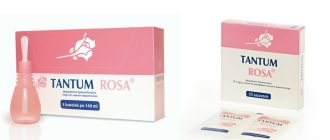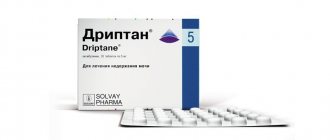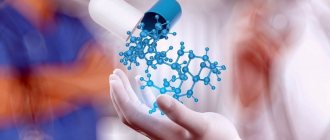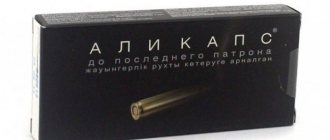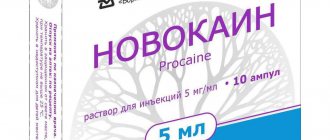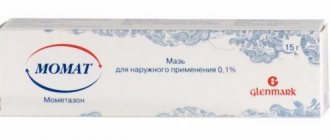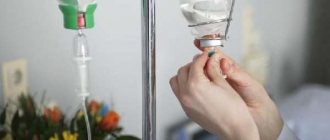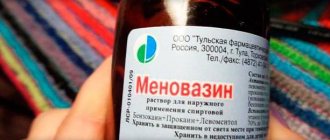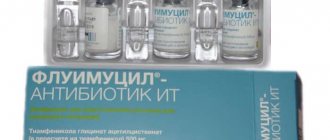Release form and composition
Dosage forms of Novocaine:
- Injection solution 0.5%: colorless, transparent liquid (2, 5 or 10 ml per ampoule; 10 ampoules in a cardboard box, complete with a scarifier or ampoule knife);
- Injection solution 2%: colorless, transparent or slightly colored liquid (2 or 5 ml per ampoule, 10 ampoules in a cardboard box, complete with a scarifier or ampoule knife; 5 ampoules in a strip pack, 2 packs in a cardboard box, complete with a scarifier or an ampoule knife. Packs with ampoules with a ring or a break point do not include a scarifier or an ampoule knife);
- Solution for injection 0.25% (1, 2, 5 or 10 ml per ampoule, 10 ampoules in a cardboard box);
- Solution for injection 1% (1, 2 or 5 ml in an ampoule, 10 ampoules in a cardboard box);
- Rectal suppositories (5 pcs each in a contour package, 2 packages in a cardboard box; 5 pcs each in a contour-free packaging, 2 packages in a cardboard box).
Active ingredient: procaine hydrochloride (in 1 ml of solution - 2.5, 5, 10 or 20 mg; in 1 suppository - 100 mg).
Additional components:
- Solution for injection: water for injection, hydrochloric acid;
- Rectal suppositories: solid fat.
Substitutes
The following medications are similar in active ingredient and pharmacological action to Novocaine:
- "Procaine."
- "Dentol".
- "Ultracaine".
- "Naropin".
- "Lidocaine."
- "Bupivacaine."
- "Buvanestin."
- "Etocaine."
- "Ambocaine."
- "Aminocaine."
- "Atoxicaine".
- "Hemocaine."
- "Cytocaine."
- "Etoscience."
- "Pankain."
- "Paracaine."
- "Planocain".
- "Syntocaine."
- "Herocaine."
- "Isocaine."
- "Marekain."
- "Minocaine."
- "Naukain."
- "Procaine."
- "Sinkain."
It is important to remember that before replacing the original drug with its generic, you must consult a doctor.
Contraindications
Injection
Absolute
- With epidural anesthesia: marked decrease in blood pressure, atrioventricular block, shock, septicemia, infection of the lumbar puncture site;
- With anesthesia using the creeping infiltrate method: pronounced fibrous changes in the tissues;
- Age up to 12 years;
- Hypersensitivity to the components of the drug (including para-aminobenzoic acid and other local anesthetic esters).
Relative (should be used with extreme caution, as there is a risk of complications):
- Emergency operations involving acute blood loss;
- Conditions accompanied by a decrease in hepatic blood flow (liver damage, chronic heart failure);
- Progression of cardiovascular failure (usually due to shock and development of blockades);
- Inflammatory diseases or infection of the injection area;
- Kidney failure;
- Pseudocholinesterase deficiency;
- Age from 12 to 18 years;
- Old age (over 65 years old).
The drug should be used with extreme caution in seriously ill and/or weakened patients, as well as during childbirth.
During pregnancy, the use of Novocaine is possible only after carefully balancing the possible benefits of taking the drug and the risk of side effects. When prescribing the drug during lactation, it is necessary to stop breastfeeding.
Rectal suppositories
- Hypersensitivity to the components of the drug (including para-aminobenzoic acid and other local anesthetic esters);
- Age up to 18 years.
Indications
According to the instructions for use, Novocain in ampoules is indicated for various types of local anesthesia, which include:
- Infiltration anesthesia.
- Perinephric, circular blockade of sensory conduction in large nerve trunks.
- Sciatica (pain in the area of the sciatic nerve).
- Neurodermatitis (chronic damage to the skin of neurogenic etiology, which occurs as an allergy and manifests itself as a rash and itching).
- Eczema and other painful conditions (acute or chronic non-contagious inflammatory skin disease, characterized by a variety of rashes and a burning sensation).
- Peripheral vascular spasms (pathological contraction of the muscles of the artery wall, which provokes a disruption of normal blood flow).
- Frostbite.
In addition, the drug is used to reduce hepatic blood flow, as well as progressive heart failure. Also, Novocaine injections are used intramuscularly to dissolve Penicillin. In addition, the drug is used as part of complex therapy for atherosclerosis, arterial hypertension, spasms of coronary vessels, endarteritis, spasms of cerebral vessels, and joint diseases.
Directions for use and dosage
Injection
For infiltration anesthesia, 0.25-0.5% solutions of the drug are prescribed; when anesthesia is carried out using the creeping infiltrate method (according to the Vishnevsky method), 0.125-0.25% solutions are prescribed. To prolong the effect of the drug and reduce absorption during local anesthesia, additionally use a 0.1% solution of epinephrine hydrochloride, adding 1 drop per 2-5-10 ml of procaine solution.
For adults, when performing infiltration anesthesia at the beginning of the operation, the first single dose should not exceed 150 ml for a 0.5% solution or 500 ml for a 0.25% solution. During the operation, it is recommended to administer no more than 400 ml for a 0.5% solution and 1000 ml for a 0.25% solution every hour.
In children over 12 years of age, the maximum single dose is 15 mg/kg.
For conduction anesthesia, use 1-2% solutions (not higher than 25 ml), for epidural - 2% solution (20-25 ml). When performing a perinephric blockade (according to A.V. Vishnevsky), a 0.5% solution in a dose of 50-80 ml or a 0.25% solution in a dose of 100-150 ml is injected into the perinephric tissue. For vagosympathetic blockade, the recommended dose of a 0.25% solution is 30-100 ml. For paravertebral or circular blockade, injections of 0.25-0.5% solution are carried out intradermally.
Rectal suppositories
The drug is administered deep into the anus, 1 suppository 1-2 times a day after bowel movements or a cleansing enema. It is recommended to use it as a local anesthetic for no more than 5 days. If pain persists after the course of treatment, you should consult your doctor.
NOVOCAINE
Solution for injection 0.5%
transparent, colorless.
Excipients: hydrochloric acid 0.1M, water for injection.
2 ml – ampoules (10) / complete with an ampoule knife or scarifier, if necessary for ampoules of this type / ) – cardboard packs. 5 ml – ampoules (10) / complete with an ampoule knife or scarifier, if necessary for this type of ampoules / ) – cardboard packs.
10 ml – ampoules (10) / complete with an ampoule knife or scarifier, if necessary for ampoules of this type / ) – cardboard packs.
pharmachologic effect
A local anesthetic with moderate anesthetic activity and a wide range of therapeutic effects. Being a weak base, it blocks Na+ channels, preventing the generation of impulses in the endings of sensory nerves and the conduction of impulses along nerve fibers.
Changes the action potential in the membranes of nerve cells without a pronounced effect on the resting potential. Suppresses the conduction of not only pain, but also impulses of other modalities.
When absorbed and directly vascularly introduced into the bloodstream, it reduces the excitability of peripheral cholinergic systems, reduces the formation and release of acetylcholine from preganglionic endings (has some ganglion-blocking effect), eliminates spasm of smooth muscles, reduces the excitability of the myocardium and motor zones of the cerebral cortex.
Eliminates descending inhibitory influences of the reticular formation of the brain stem. Inhibits polysynaptic reflexes. In large doses, it can cause convulsions. It has a short anesthetic activity (the duration of infiltration anesthesia is 0.5-1 hour).
Pharmacokinetics
Subject to complete systemic absorption. The extent of absorption depends on the site and route of administration (especially vascularization and blood flow rate of administration) and the final dose (amount and concentration).
It is quickly hydrolyzed by plasma and liver esterases to form two main pharmacologically active metabolites: diethylaminoethanol (has a moderate vasodilator effect) and para-aminobenzoic acid (is a competitive antagonist of sulfonamide drugs and can weaken their antimicrobial effect).
T1/2 – 30-50 s, in the neonatal period – 54-114 s. It is excreted primarily by the kidneys in the form of metabolites; no more than 2% are excreted unchanged.
Indications
Infiltration (including intraosseous) anesthesia; vagosympathetic cervical, perinephric, circular and paravertebral blockades.
Dosage
Only for procaine solution 5 mg/ml (0.5%).
For infiltration anesthesia
350-600 mg (70-120 ml) are administered.
Higher doses for infiltration anesthesia for adults
: the first single dose at the beginning of the operation is no more than 0.75 g (150 ml), then during each hour of the operation no more than 2 g (400 ml) of solution.
With perinephric block
(according to A.V. Vishnevsky) 50-80 ml are injected into the perinephric tissue.
With circular and paravertebral blockade
5-10 ml are injected intradermally. For vagosympathetic blockade, 30-40 ml is administered.
To reduce absorption and prolong the action of local anesthesia
, additionally inject a 0.1% solution of epinephrine hydrochloride - 1 drop per 2-5-10 ml of procaine solution.
Maximum dose for use in children over 12 years of age
– 15 mg/kg.
From the central and peripheral nervous system:
headache, dizziness, drowsiness, weakness, trismus.
From the cardiovascular system:
increased or decreased blood pressure, peripheral vasodilation, collapse, bradycardia, arrhythmias, chest pain.
From the hematopoietic organs:
methemoglobinemia.
Allergic reactions:
itching of the skin, skin rash, other anaphylactic reactions (including anaphylactic shock), urticaria (on the skin and mucous membranes). If, while using the drug, any of the side effects indicated in the instructions appear or they get worse, or you notice any other side effects not listed in the instructions, inform your doctor.
Overdose
Symptoms:
pallor of the skin and mucous membranes, dizziness, nausea, vomiting, “cold” sweat, increased breathing, tachycardia, decreased blood pressure, even collapse, apnea, methemoglobinemia. The effect on the central nervous system is manifested by a feeling of fear, hallucinations, convulsions, and motor agitation.
Treatment:
maintaining adequate pulmonary ventilation, detoxification and symptomatic therapy.
Pregnancy and lactation
If it is necessary to prescribe the drug during pregnancy, the expected benefit to the mother should be compared with the potential risk to the fetus. With caution during childbirth.
If it is necessary to use the drug during lactation, the issue of stopping breastfeeding should be decided.
Use in childhood
Contraindicated for children under 12 years of age. Use with caution in children aged 12 to 18 years.
For impaired renal function
Use with caution in case of renal failure.
For liver dysfunction
Use with caution in case of liver diseases.
Use in old age
Use with caution in elderly patients (over 65 years of age).
Conditions for dispensing from pharmacies
The drug is available with a prescription.
Storage conditions and periods
Store the drug in a place protected from light, at a temperature not exceeding 25°C. Keep out of the reach of children.
Shelf life – 3 years. Do not use after the expiration date stated on the packaging.
The description of the drug NOVOCAINE is based on officially approved instructions for use and approved by the manufacturer.
Found an error? Select it and press Ctrl+Enter.
Source: https://health.mail.ru/drug/novocaine/
Side effects
- Cardiovascular system: chest pain, arrhythmias, bradycardia, collapse, peripheral vasodilation, decreased or increased blood pressure;
- Nervous system: trismus, weakness, drowsiness, dizziness, headache, convulsions, cauda equina syndrome;
- Urinary system: involuntary urination;
- Hematopoietic organs: methemoglobinemia;
- Digestive system: vomiting, nausea, involuntary bowel movements;
- Allergic reactions: skin rash, skin itching, urticaria (on mucous membranes and skin), anaphylactic reactions (including anaphylactic shock);
- Other: hypothermia, persistent anesthesia, return of pain; during anesthesia in dentistry - prolongation of anesthesia, paresthesia and numbness of the lips and tongue;
- Local reactions: a feeling of discomfort and the urge to defecate (observed in the first days of using suppositories and goes away on their own, without requiring discontinuation of therapy); rarely - itching and hyperemia in the anal area (when used in high doses).
Symptoms of an overdose of Novocaine are: vomiting, nausea, dizziness, pallor of the mucous membranes and skin, increased breathing, “cold” sweat, decreased blood pressure (up to collapse), tachycardia, methemoglobinemia, apnea, feelings of fear, hallucinations, motor agitation, convulsions . In this condition, measures are taken to maintain adequate ventilation of the lungs, detoxification and symptomatic therapy are carried out.
How to prepare a compress mixture
When applying a bandage to the lower back during intense pain, it is necessary to first moisten a towel or gauze with the prepared composition, then wring it out and wrap it around the back. Place special paper or plastic film on top. Next, apply an insulating layer, which should consist of woolen fabric.
You can use a woolen blanket or scarf for this. The duration of the therapy procedure using an analgesic compress is initially about three hours. In the next 24 hours, when the pain ceases to be intense, the duration of the compress can be increased to eight hours. The course of therapy includes fifteen procedures.
special instructions
Before using the drug, it is mandatory to conduct tests for individual sensitivity to its components.
In the case of therapy with monoamine oxidase inhibitors, the use of the latter must be discontinued 10 days before using the local anesthetic.
It should be borne in mind that when the same total dose of the drug is administered, the toxicity of procaine is directly proportional to the concentration of the solution used.
During the administration of the drug, it is necessary to monitor the activity of the central nervous, respiratory and cardiovascular systems.
When applied cutaneously, Novocain does not provide surface anesthesia.
During the period of therapy, it is recommended to refrain from driving vehicles and operating other complex mechanisms.
What does it help with?
The range of uses of the drug is wide:
- used for local infiltration anesthesia, used as an adjuvant for general anesthesia, for circular and paravertebral blockade;
- recommended for pain during exacerbation of peptic ulcer of the duodenum and stomach, for hemorrhoids and spasm of blood vessels;
- used to eliminate pain due to osteochondrosis during the electrophoresis procedure;
- widely used in the treatment of ophthalmological diseases (by instillation into the eyes for burns);
- when administering Ceftriaxone, Cortexin, Cefazolin, Magnesia or Lidase, the medication is administered together with these drugs to neutralize their pain;
- in gynecology and other medical fields, the drug is used to alleviate the postoperative period (intravaginally - using tampons, nasally - in the form of inhalations);
- as a local anesthesia in the treatment of toothache (together with Analgin or Glucose);
- helps relieve unpleasant symptoms of fungus, stop its spread, is used as lotions or applications;
- has been widely used in cosmetology to eliminate the symptoms of aging; it is used in the electrophoresis procedure in combination with vitamin B;
- helps relieve sharp pain during otitis - drops in the ear.
Drug interactions
It is necessary to take into account that when combined with Novocaine:
- Warfarin, heparin sodium, enoxaparin sodium, danaparoid sodium, dalteparin sodium, ardeparin sodium (anticoagulants) - increase the risk of bleeding;
- Trimethaphane, mecamylamine, guanethidine, guanadrel - increase the risk of a sharp decrease in blood pressure and bradycardia;
- Disinfectant solutions containing heavy metals (when treating the injection site) - increase the risk of swelling and pain at the injection site;
- Selegiline, procarbazine, furazolidone (monoamine oxidase inhibitors) - aggravate the threat of severe hypotension;
- Phenylephrine, methoxamine, epinephrine (vasoconstrictors) – prolong the local anesthetic effect;
- Narcotic analgesics - lead to an additive effect, which is used in epidural and spinal anesthesia (in this case, increased respiratory depression is noted);
- Ecothiopathy iodide, demecaria bromide, thiotepa, cyclophosphamide, antimyasthenic drugs (cholinesterase inhibitors) - reduce the rate of drug metabolism.
The effect of Novocaine on simultaneously taken substances/drugs:
- Muscle relaxants – prolongs and enhances their effect;
- Medicines for general anesthesia, sedatives, hypnotics, tranquilizers - aggravates the inhibitory effect on the central nervous system;
- Antimyasthenic drugs – reduces their effectiveness (requires correction of myasthenia gravis therapy);
- Sulfonamides - weakens the antibacterial effect, since the metabolite of procaine (para-aminobenzoic acid) is a sulfonamide antagonist.
Novocaine (0.5%, 2ml, 5ml, Khimpharm JSC)
Solution for injection 0.5% 2 ml, 5 ml; 2% 2 ml
Description
Transparent, colorless or slightly yellowish liquid.
Pharmacotherapeutic group
Anesthetics. Local anesthetics. Aminobenzoic acid esters. Procaine
ATX code N01BA02
Directions for use and doses
The dose and concentration of Novocaine solution depend on the nature of the surgical intervention, method of administration, condition and age of the patient,
The drug is used intradermally, intramuscularly, intravenously.
For local anesthesia
For infiltration anesthesia, 0.25% - 0.5% solutions are used (no more than 1 g for a single injection); for anesthesia using the method of tight creeping tissue infiltration (according to A.V. Vishnevsky) - 0.125% - 0.25% solutions; for conduction, epi- and epidural anesthesia – 2% solution 20-25 ml; for spinal anesthesia – 2% solution 5 ml.
For infiltration anesthesia, the following maximum doses are established (for adults): the first single dose at the beginning of the operation is not more than 1.25 g (500 ml of 0.25% solution) or 0.75 g (150 ml of 0.5% solution). Subsequently, during each hour of surgery - no more than 2.5 g (1000 ml of 0.25% solution) or 2 g (400 ml of 0.5% solution) (up to 0.5 g once without adrenaline and 1 g with adrenaline) .
To reduce absorption and prolong the action, Novocaine is used together with a 0.1% solution of adrenaline, which is added aseptically at the rate of 1 drop per 2-5 ml of Novocaine solution.
It is possible to use the drug during intraosseous anesthesia - 0.25% solution 50-150 ml.
To carry out blockades
For paravertebral blockade for eczema and neurodermatitis, intradermal injections of 0.25% 70-100 ml of Novocaine solution are recommended in the projection area of the sensitive nerve trunks.
For perinephric blockade (according to A.V. Vishnevsky), 50-80 ml of a 0.5% solution or 100-150 ml of a 0.25% Novocaine solution is injected into the perinephric tissue.
For vagosympathetic blockade - 30-100 ml of 0.5% Novocaine solution.
Maximum doses of Novocaine (for adults): for intramuscular administration, a single dose is 0.1 g, for intravenous administration, a single dose is 0.05 g; The daily dose for parenteral administration is 0.1 g.
If it is necessary to use lower concentrations of Novocaine (0.125% or 0.25%), the drug is diluted with a sterile isotonic sodium chloride solution to the required concentration before use.
Intravenous administration is carried out slowly, in an isotonic sodium chloride solution.
Doses in pediatric practice are determined depending on body weight, but not more than 15 mg/kg body weight.
Drug interactions
When administered intravenously, Novocaine enhances the inhibitory effect on the central nervous system of general anesthesia, sleeping pills, sedatives, narcotic analgesics and tranquilizers.
When the drug is prescribed together with narcotic analgesics, an additive effect is noted, which is used during spinal and epidural anesthesia, while respiratory depression increases.
Vasoconstrictors (epinephrine, methoxamine, phenylephrine) prolong the local anesthetic effect of Novocaine.
The drug prolongs the neuromuscular blockade caused by suxamethonium, since both drugs are hydrolyzed by plasma cholinesterase.
Novocaine enhances and prolongs the effect of muscle relaxants.
Novocaine reduces the antimyasthenic effect of drugs, especially when used in high doses, which requires additional correction of the treatment of myasthenia gravis.
Cholinesterase inhibitors (antimyasthenic drugs, cyclophosphamide, demecarine, ecothiophate, thiotepa) reduce the metabolism of Novocaine, so their joint administration is not recommended.
Anticoagulants (ardeparin, dalteparin, danaparoid, enoxaparin, heparin, warfarin) when used together with Novocaine increase the risk of bleeding.
Use with MAO inhibitors (furazolidone, procarbazine, selegiline) increases the risk of hypotension, so they should be discontinued 10 days before the local anesthetic.
When using Novocaine with guanadrel, guanethidine, mecamylamine, trimethaphan, the risk of a sharp decrease in blood pressure and bradycardia increases.
Novocaine metabolite para-aminobenzoic acid is a competitive antagonist of sulfonamides and can weaken their antimicrobial effect, so the simultaneous use of these drugs is not recommended.
When treating the Novocaine injection site with disinfectant solutions containing heavy metals, the risk of developing a local reaction in the form of pain and swelling increases.
Release form and packaging
0.5% solution, 2 ml No. 5 or No. 10; 2% solution of 2 ml No. 5 or No. 10 in neutral glass ampoules for syringe filling or imported sterile ampoules for syringe filling, with a break point or break ring.
0.5% solution of 5 ml No. 5 in neutral glass ampoules or in neutral glass ampoules for syringe filling or imported sterile ampoules for syringe filling, with a break point or break ring.
A label made of label or writing paper is affixed to each ampoule.
A 0.5% solution of 2 ml, 5 or 10 ampoules each, or 5 ml, 5 ampoules each, is packaged in a blister pack made of polyvinyl chloride film and aluminum or imported foil.
A 2% solution of 2 ml, 5 or 10 ampoules each, is packaged in a blister pack made of polyvinyl chloride film and aluminum or imported foil.
Outline packages, together with approved instructions for medical use in the state and Russian languages, are placed in boxes made of cardboard or corrugated cardboard. The number of instructions for medical use is included in the number of packages.
Storage conditions
Store in a place protected from light, at a temperature not exceeding 250C.
Keep out of the reach of children!
Shelf life
3 years
Do not use after expiration date.
, The Republic of Kazakhstan,
Shymkent, st. Rashidova, 81
Content
- 1 History
- 2 Pharmacological action
- 3 Pharmacokinetics
- 4 Indications
- 5 Contraindications
- 6 Dosage regimen
- 7 Side effects 7.1 From the central and peripheral nervous system
- 7.2 From the cardiovascular system
- 7.3 From the urinary system
- 7.4 From the digestive system
- 7.5 Blood side effects
- 7.6 Allergic reactions
- 7.7 Other
- 8.1 Symptoms
